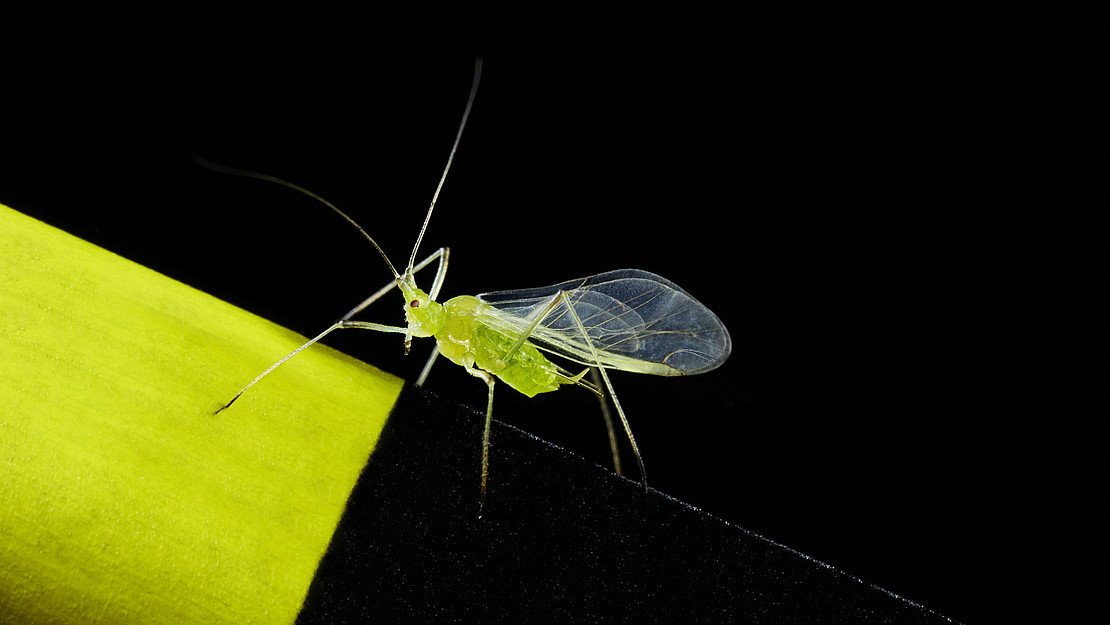This page contains automatically translated content.
Aphids and their favorite colors
 Image: Jean-Louis Wolff & Sascha M. Kirchner.
Image: Jean-Louis Wolff & Sascha M. Kirchner.In the garden, aphids are among the rather unpopular guests. In agriculture, the small insects can cause all the more damage. But how do they actually select their host plants? What are the basic mechanisms behind this? Researchers at the Universities of Bonn and Kassel have now presented two novel models that can be used to analyze color vision and thus the reaction of aphids to plants. This opens up new possibilities for future research on this topic - but may also be relevant for agricultural applications. The study has appeared in the journal Philosophical Transactions of the Royal Society B.
It has been known for years that aphids are particularly fond of the color yellow, which is why yellow color traps are sometimes used in agriculture. They record the pressure that the animals exert on crops. For their current study, the researchers set up a total of more than 200 color traps with around 70 different colors in the field in two successive springs.
Using a light spectrometer, they measured the so-called reflectance spectra of each color for each wavelength. "The spectrometer allows us to quantify the colors objectively. This is important because humans perceive colors very differently than insects - so we can't rely on our eyes for that," says study leader Prof. Dr. Thomas F. Döring of the Institute of Crop Sciences and Resource Conservation (INRES) at the University of Bonn.
The reflectance data and the behavioral data, i.e. the number of aphids caught per trap, then formed the basis for two mathematical models. The aim was to correlate the reflectance and behavioral data - and thus find out which wavelengths are crucial for the aphids' response.
Two models with similar results
In the first model, the scientists incorporated already known data about which photoreceptors are stimulated when aphids search for food. The second model did without the physiological data and took into account only the behavior of the animals and the measured reflectance data per color. For this model, the scientists applied a special static method called partial least squares regression (PLSR) approach.
Both models produced similar results. First, they confirmed the aphids' preference for the color yellow. Second, both models suggested a specific neural mechanism that controls the aphids' visual behavior. "The fact that the results of both evaluations ended up coinciding in such a way surprised us ourselves," says Dr. Sascha M. Kirchner of the University of Kassel. "But the result is so strong that it cannot be a mathematical artifact."
One conclusion drawn by the researchers is that even for aphid species for which no physiological data are yet available, the new evaluation method - together with selected color stimuli - can help track visual behavior more precisely. "In this way, we could save on costly electrophysiological examinations of the animals in the future," emphasizes Döring, a member of the Transdisciplinary Research Area "Sustainable Futures" and the PhenoRob Cluster of Excellence at the University of Bonn.
Bridge between biology and agriculture
With their study, the scientists unite biological and agricultural research in a special way. In neurobiology, lice do not normally serve as model organisms to study fundamental mechanisms. In agriculture, on the other hand, such behavioral analyses are often not applied due to their level of detail. "In our study, we tried to build a bridge between applied science and basic research," says field ecologist Thomas Döring.
Specifically, the new models could help optimize existing agricultural practices, such as so-called mulching methods that can alter the visual background of crops and thus "hide" host plants from pests. The results could also be relevant for attempts to change leaf color, for example through breeding or special fertilization. The current study already provides evidence that wheat leaves are more attractive to aphids when fertilized with low levels of nitrogen than when treated more intensively with nitrogen.
Why actually yellow?
The question remains open as to why aphids actually have such a preference for yellow - after all, their food is green plant leaves. "Physiologically, this can now be explained, but what benefit for the aphids lies behind it is still unclear," says Thomas Döring.
In future studies, he and his colleagues would like to investigate the effect of UV light in more detail, which is interesting both for application in crop protection and from a biological perspective.
In addition, the study provides initial indications that some aphid species react somewhat differently than most others. Whether this behavior is fundamentally different also needs to be clarified in further studies.
Funding:
The study was supported by the German Research Foundation (DFG), the Entomological Fund, the Department for Environment, Food and Rural Affairs (Defra) of the UK government and the Agriculture and Horticulture Development Board in the UK.
Publication:
Thomas F. Döring & Sascha M. Kirchner: A model for color preference behavior of spring migrant aphids. Philosophical Transactions of the Royal Society B; https://doi.org/10.1098/rstb.2021.0283
Contact:
Prof. Dr. Thomas Döring
Department of Agroecology and Organic Agriculture
Institute of Crop Science and Resource Conservation (INRES)
University of Bonn
Tel: +49 228 735143
E-mail: tdoering[at]uni-bonn[dot]de
Dr. Sascha Kirchner
Department of Organic Agricultural Sciences
University of Kassel
Tel: +49 5542 98-1651
E-Mail: Sascha.Kirchner[at]uni-kassel[dot]de
Press contact:
Sebastian Mense
University of Kassel
Communications, Press and Public Relations
Tel. 0561 804-1961
E-mail: Press[at]uni-kassel[dot]de